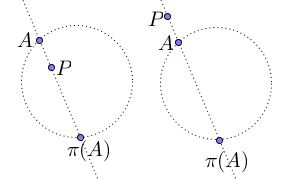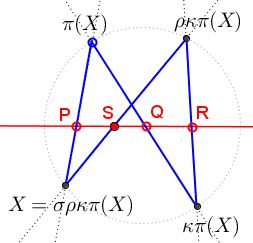Two Butterflies Theorem as a Porism of Cyclic Quadrilaterals
What Is This About?
Introduction
The following is a part of Jerzy Kocik's paper A porism concerning cyclic quadrilaterals (Geometry, Volume 2013 (Jun 2013), Article ID 483727.)
The main tool of the article, referred there as the reversion in a circle through a point and the associated Möbius transform have been discovered independently by Nathan Bowler in 2002 in his proof of the Two Butterflies Theorem. Jerzy Kocik extends Nathan's result in several ways: explicit matrix representation of the Möbius transform; its application to any straight line, not necessarily a chord in a circle and to any nondegenerate conic section.
Reversion in a Circle
Given a circle $\omega\;$ and point $P\notin\omega,\;$ the reversion in the circle $\pi:\;\omega\rightarrow\omega\;$ through $P\;$ is the mapping of $\omega\ni A\mapsto\pi (A)\in\omega,\;$ such that points $A,\;$ $P,\;$ and $\pi (A)\;$ are collinear:

If $P\in\omega\;$ then for any $A\in\omega,\;$ $\pi (A)=P.$
Clearly, for $P\notin\omega,\;$ $\pi\;$ is an involution, $\pi^2=id,\;$ and is, therefore, invertible.
Matrix Representation of Reversion
Interpret each point $P\;$ as a complex number $p\in\mathbb{C}.\;$ Without loss of generality, we shall assume that $\omega\;$ is the unit circle, $\omega = \{z\in\mathbb{C}:\; |z|^2 = 1\}.\;$ Complex conjugation is denoted in two ways (an overbar or an asterisks).
Reversion in the unit circle $\omega\;$ through point $p\in\mathbb{C}\;$ corresponds to a Möbius transformation:
$\displaystyle z\mapsto\;z'=\begin{bmatrix}1&-p\\\overline{p}&-1\end{bmatrix}\cdot z=\frac{z-p}{\overline{p}z-1}.$
Note that the Möbius transform is defined up to a scalar factor and, therefore, so is the associated matrix.
We first check that reversions leave the unit circle invariant: if $|z|=1\;$ then also $|z'|=1:$
$\displaystyle\begin{align} |z'|^2 &= \left(\frac{z-p}{\overline{p}z-1}\right)\left(\frac{z-p}{\overline{p}z-1}\right)^{*}\\ &=\frac{|z|^2-z\overline{p}-p\overline{z}+|p|^2}{|p|^2|z|^2-\overline{p}z-p\overline{z}+1}\\ &=\frac{1-z\overline{p}-p\overline{z}+|p|^2}{|p|^2-\overline{p}z-p\overline{z}+1}\\ &=1. \end{align}$
Next we show that, for any $z\in\omega,\;$ if $z'\ne z,\;$ points $z,p,z'\;$ are collinear.
$\displaystyle\begin{align} \frac{z'-p}{z-p} &= \frac{\displaystyle\frac{z-p}{\overline{p}z-1}-p}{z-p}=\frac{(z-p)-p(\overline{p}z-1)}{(z-p)(\overline{p}z-1)}\\ &=\frac{\overline{z}}{\overline{z}}\frac{z-|p|^2z}{(z-p)(\overline{p}z-1)}\\ &=\frac{1-|p|^2}{\overline{p}z+p\overline{z}-|p|^2-1}\\ &=\frac{1-|p|^2}{2\Re (\overline{p}z)-|p|^2-1}\in\mathbb{R}, \end{align}$
In case $z'=z,\;$ $\displaystyle\frac{z'-p}{z-p}=1,\;$ and from the last line above, $\displaystyle 1=\frac{1-|p|^2}{2\Re (\overline{p}z)-|p|^2-1}\in\mathbb{R}\;$ from which $\Re (\overline{p}z)=1.\;$ So that $\overline{p}z+p\overline{z}=2\;$ and, since $|z|^2=1,\;$ $\overline{(p-z)}z+(p-z)\overline{z}=0,\;$ making $p-z\;$ and $z\;$ perpendicular. This means that $p\;$ lies on the tangent to $\omega\;$ at $z,\;$ implying that $z\;$ is a double point of the reversion.
Several Statements
Here's the statement of the Butterfly Porism:
Let $P,\;$ $Q,\;$ $R,\;$ $S\;$ be collinear points, $\omega,\;$ a circle; $\pi,\;$ $\kappa,\;$ $\rho,\;$ $\sigma,\;$ be the corresponding reversions. $\zeta = \sigma\rho\kappa\pi,\;$ their composition. Then
if $\exists X\in\omega\;$ with $\zeta (X) = X,\;$ then $\forall X\in\omega,\;$ $\zeta (X) = X.$

Here's an equivalent version:
Let $\omega\;$ be a circle and $\ell\;$ a line with three points $P,\;$ $Q,\;$ $R.\;$ Let $X\;$ be a point on the circle. The point $S,\;$ the intersection of line $\ell\;$ with line $[\rho\kappa\pi (X), X],\;$ does not depend on $X\in\omega.$
And here is a more general statement:
The composition of three point reversions $\rho\kappa\pi\;$ of a circle is a reversion if and only if points $P,\;$ $Q\;$ and $R\;$ are collinear.
This is the statement we shall proof below.
Proof
Consider the product of the consecutive reversions through $P,\;$ $Q,\;$ $R,\;$ as represented by matrices:
$\begin{align}M&=\begin{bmatrix}1&-r\\ \overline{r}&-1\end{bmatrix}\begin{bmatrix}1&-q\\ \overline{q}&-1\end{bmatrix}\begin{bmatrix}1&-p\\ \overline{p}&-1\end{bmatrix}\\ &=\begin{bmatrix}1-\overline{p}q+\overline{q}r-r\overline{p}&-p+q-r+p\overline{q}r\\ \overline{p}-\overline{q}+\overline{r}-\overline{p}q\overline{r}&-1+p\overline{q}-q\overline{r}+\overline{r}p\end{bmatrix}\end{align}$
Note right away that $M_{12}=-\overline{M_{21}}.\;$
Now, since $p,\;$ $q,\;$ $r\;$ are collinear, $r=mp+nq,\;$ where $m+n=1\;$ and $m,n\in\mathbb{R}.\;$ Then $M_{11}=1-m(\overline{p}q+p\overline{q})+m|p|^2-n|q|^2\in\mathbb{R}\;$ and similarly for $M_{22}=-1+m(\overline{p}q+p\overline{q})-m|p|^2+n|q|^2\in\mathbb{R}\;$ such that $M_{11}=-M_{22}.$
Thus $M\;$ corresponds to a Möbius transform and, hence, to a reversion. Since the transform and the matrix are defined up to a scalar, we divide every entry by $M_{11}\;$ to obtain
$\displaystyle M=\begin{bmatrix}1&\frac{-p+q-r+p\overline{q}r}{1-\overline{p}q+\overline{q}r-r\overline{p}}\\ \frac{\overline{p}-\overline{q}+\overline{r}-\overline{p}q\overline{r}}{1-\overline{p}q+\overline{q}r-r\overline{p}}&-1\end{bmatrix}=\begin{bmatrix}1&-s\\ \overline{s}&-1\end{bmatrix}$
which is clearly a matrix of reversion through point $\displaystyle s=\frac{p-q+r-p\overline{q}r}{1-\overline{p}q+\overline{q}r-r\overline{p}}.\;$ It remains to verify that $s\;$ is collinear with $p,\;$ $q\;$ and $r.\;$
The line of $p,q,r\;$ crosses $\omega\;$ in two points, say $A\;$ and $B\;$ such that $\pi (A)=B,\;$ $\kappa\pi (A)=A,\;$ $\rho\kappa\pi (A)=B,\;$ implying that $\sigma (A)=B,\;$ i.e., that $s\;$ lies on $AB.$
In case where the line of $p,q,r\;$ does not cross $\omega\;$ it is not difficult to verify that, say, $\displaystyle\frac{s-p}{q-r}\in\mathbb{R}.$
Butterfly Theorem and Variants
- Butterfly theorem
- 2N-Wing Butterfly Theorem
- Better Butterfly Theorem
- Butterflies in Ellipse
- Butterflies in Hyperbola
- Butterflies in Quadrilaterals and Elsewhere
- Pinning Butterfly on Radical Axes
- Shearing Butterflies in Quadrilaterals
- The Plain Butterfly Theorem
- Two Butterflies Theorem
- Two Butterflies Theorem II
- Two Butterflies Theorem III
- Algebraic proof of the theorem of butterflies in quadrilaterals
- William Wallace's Proof of the Butterfly Theorem
- Butterfly theorem, a Projective Proof
- Areal Butterflies
- Butterflies in Similar Co-axial Conics
- Butterfly Trigonometry
- Butterfly in Kite
- Butterfly with Menelaus
- William Wallace's 1803 Statement of the Butterfly Theorem
- Butterfly in Inscriptible Quadrilateral
- Camouflaged Butterfly
- General Butterfly in Pictures
- Butterfly via Ceva
- Butterfly via the Scale Factor of the Wings
- Butterfly by Midline
- Stathis Koutras' Butterfly
- The Lepidoptera of the Circles
- The Lepidoptera of the Quadrilateral
- The Lepidoptera of the Quadrilateral II
- The Lepidoptera of the Triangle
- Two Butterflies Theorem as a Porism of Cyclic Quadrilaterals
- Two Butterfly Theorems by Sidney Kung
- Butterfly in Complex Numbers
|Contact| |Front page| |Contents| |Geometry|
Copyright © 1996-2018 Alexander Bogomolny73486826
